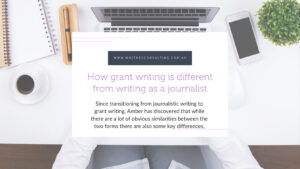Struggling to explain why your project truly matters in a grant application? A compelling needs statement is one of the most critical components of any funding proposal—but often the most overlooked. This section sets the tone, builds credibility, and gives funders a clear reason to invest in your cause. Done well, it can transform a standard application into a persuasive case for support.
At Whitney Consulting, we specialise in helping organisations across Australia, including Perth, Regional WA, Sydney, Queensland, and Adelaide articulate their project’s urgency, relevance, and potential. In this blog, we break down exactly how to write a powerful needs statement that gets noticed.
What Is a Needs Statement and Why Does It Matter?
What is a needs statement?
A needs statement is the foundation of your grant application. It explains the problem your project aims to solve and makes the case for why that problem deserves funding. Think of it as the “why” behind your entire proposal.
Why it matters in grant writing
Too often, applicants jump straight into describing what they want to do—without clearly establishing why it needs to be done. Funders want to know their money will address a real issue, not just support a good idea. That’s why a strong needs statement is critical: it shows that your project is not only worthwhile but necessary.
What your needs statement should include
Your needs statement should:
- Define the problem clearly and specifically.
- Show who is affected and how.
- Present evidence that the problem exists and needs urgent attention.
The foundation of your proposal
When crafted well, the needs statement becomes the heartbeat of your application. It connects emotionally and intellectually with the reader, laying the groundwork for everything that follows.
Research-Backed Storytelling: Combining Data and Narrative
Lead with reliable data
Effective needs statements are a blend of cold, hard facts and warm, human stories. Relying solely on statistics can feel dry; using only emotion can come across as unfocused. The real power lies in combining the two.
Humanise the numbers
Start with robust data. Use local and national statistics, community surveys, reports from government bodies, and academic research. This shows funders you’ve done your homework and understand the broader context of the issue. But don’t stop there.
Use community voices and case studies
Bring your data to life with real-world examples. For instance, if you’re applying for funding to reduce youth unemployment in a remote community, include a short case study or quote from someone directly impacted. Personal experiences make the data meaningful and memorable.
Strike a compelling balance
Need help balancing these elements? Our team includes expert grant writers who are skilled at turning technical data into compelling, funder-friendly content. At Whitney Consulting, we help you find the right words—and the right rhythm—to ensure your needs statement is as persuasive as it is accurate.
Aligning the Need with the Funder’s Priorities
Know your audience
Even the most compelling needs statement will fall flat if it doesn’t align with the funder’s objectives. Before you begin writing, study the grant guidelines, the organisation’s mission, and any available past funding outcomes. What problems do they want to solve? What language do they use?
Show strategic fit
Your job is to draw a direct line between the issue you’re addressing and the funder’s stated goals. For example, if you’re applying to a program focused on improving community wellbeing, explain how the need you’re addressing directly impacts physical, mental, or social health.
Practical ways to align
Practical ways to show alignment:
- Mirror the funder’s language (without copying).
- Reference their strategic priorities explicitly.
- Explain how your project addresses specific criteria.
Decode funder expectations
At Whitney Consulting, we take pride in offering a grant writing service that looks beyond the words on the page. We assess strategic alignment to ensure that the needs we communicate in applications aren’t just strong—they’re relevant. With our support, your proposal will speak directly to what the funder cares about most.
Framing the Problem Clearly and Impactfully
Keep it clear and specific
Clarity is everything. Your needs statement should describe the problem in simple, accessible language. Avoid jargon, acronyms, or buzzwords that may confuse the reader. Instead, focus on telling a straightforward story: who is affected, what is the issue, and why does it matter?
Be specific. “Our region suffers from poor educational outcomes” is vague. “Only 43% of Year 12 students in our local area graduate with a university entrance score, compared to the national average of 78%” is specific and powerful.
Focus on root causes
Another key to strong framing is identifying root causes rather than just symptoms. Instead of saying “Our community has high unemployment,” dig deeper. Is the issue related to lack of transport, limited job training, or systemic barriers?
Connect to your solution
A strong needs statement leads naturally into your proposed solution. By clearly outlining the problem, you help the reader understand why your approach is the logical next step.
Refine for impact
Many organisations struggle with this section—not because they don’t understand the issue, but because they find it difficult to articulate. That’s where professional grant writers can make a real difference. Our team at Whitney Consulting helps refine your needs statements to ensure they are clear, concise, and strategically written to connect with funders.
Common Pitfalls and How to Avoid Them
Mistake 1: Vague descriptions
Even well-intentioned grant writers can make mistakes when drafting a needs statement. Here are some of the most common issues we see—and how to avoid them.
Saying “there is a need for more services” without specifying what services, for whom, or why, won’t cut it. Always include context and evidence.
Mistake 2: Assuming funder understanding
Avoid assuming the funder knows your community or the issue. Instead, walk them through it clearly with data and explanations.
Mistake 3: Overuse of emotion
While passion is important, your statement shouldn’t feel like an opinion piece. Balance your conviction with evidence.
Mistake 4: No broader context
A needs statement that doesn’t connect to broader social, economic, or policy issues risks being seen as too narrow or isolated.
How to avoid these traps
So how can you build confidence in writing needs statements that avoid these traps? Participating in an online grant writing workshop or signing up for hands-on grant writing training is a great place to start. These programs help you learn the right structure, tone, and strategies to craft stronger applications.
At Whitney Consulting, we also offer one-on-one coaching, editing, and support to help refine needs statements—so your funding application is as strong as your project vision.
Make Your Words Count Where It Matters Most
Is your needs statement helping or hurting your funding chances? A strong, well-researched, and clearly articulated needs statement can make the difference between an application that gets overlooked and one that secures funding. From combining data with story, to aligning with funder goals and avoiding common pitfalls, it’s a critical piece of your grant success strategy.
With support from Whitney Consulting—whether through expert advice, writing services, or training—you can craft needs statements that not only inform, but inspire. Ready to strengthen your next grant application? We’re here to help.





